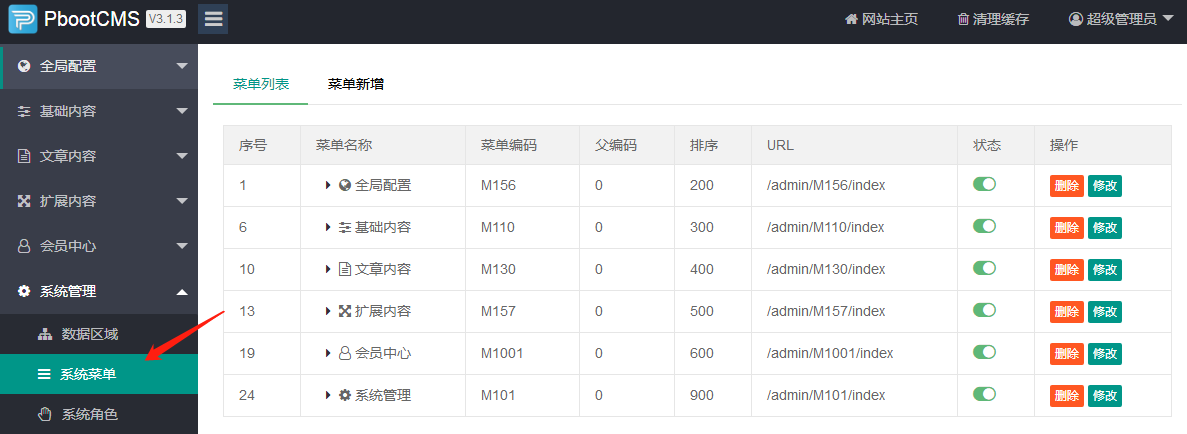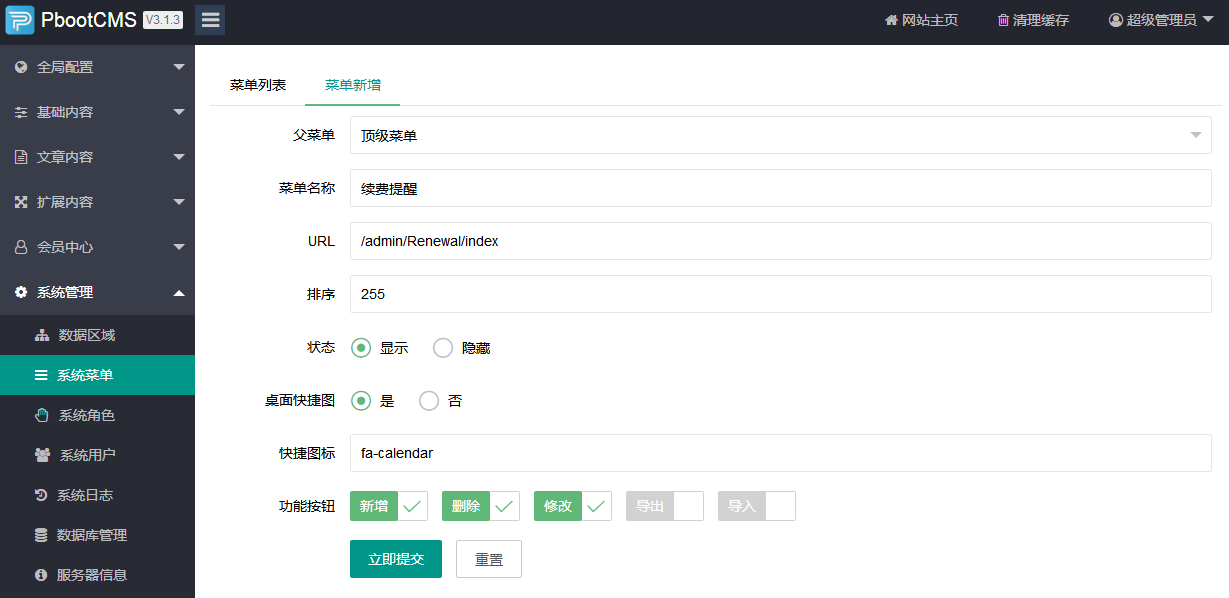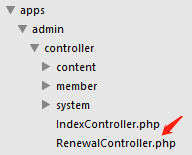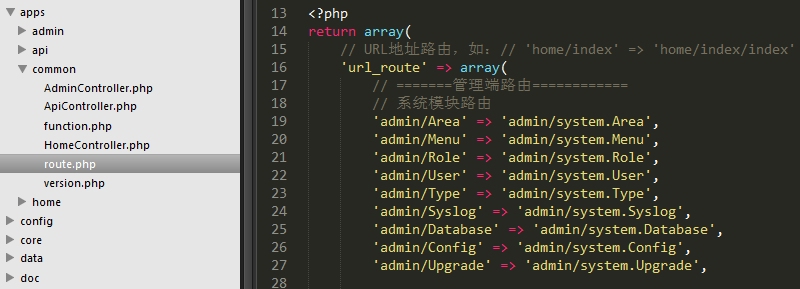最近再用PbootCMS做一些二次开发,开发涉及到【菜单】【权限】等等,做一个简单的记录,方便后期快速理清开发思路。
一、改为Mysql
对于PbootCMS用来二次开发,就不要用sqlite来开发了。
修改文件:config/database.php

二、开放系统菜单
默认的系统是没有【系统菜单】功能的,需要改数据库。
修改数据库:ay_menu 数据表,系统菜单的状态改为:1

重新登录系统:

三、图标的使用
PbootCMS使用的是 fontawesome 字体图标库,该图标库收录了675个图标。
http://www.fontawesome.com.cn/faicons/
四、新建目录
例如我们新建一个【续费提醒】模块:

再次增加一个【续费客户】菜单:

重新登录后,就可以看到侧栏菜单。
五、新建控制器
默认情况,我们新建模块,需要在 apps/admin/controller 目录下新建控制器

例如:RenewalController.php
配置好命名空间后即可访问。
但是我们看上面的配置都是分模块的,例如:content,member,system,这个在哪里配置呢?
分模块配置,需要单独的配置路由:
位置:apps / common / route.php

六、get 函数
在使用PbootCMS进行二次开发的时候,经常会看到使用 get 函数,例如:
$id = get('id', 'int'); $mcode = get('mcode', 'var'); $keywords = get('keywords', 'vars');
通过该 get 函数,可以用于接收参数,并且制定类型,具体函数类型:core / function / helper.php

然后是这个 filter 方法:
function filter($varname, $condition) { // 变量名称文本 if (array_key_exists($varname, $condition) && $condition[$varname]) { $vartext = $condition[$varname]; } else { $vartext = $varname; } // 数据源 if (array_key_exists('d_source', $condition)) { switch ($condition['d_source']) { case 'post': $data = @$_POST[$varname]; break; case 'get': $data = @$_GET[$varname]; break; case 'cookie': $data = @$_COOKIE[$varname]; break; case 'session': $data = session($varname); break; case 'both': $data = @$_POST[$varname] ?: @$_GET[$varname]; break; case 'string': $data = $varname; default: error($vartext . '数据获取方式设置错误!'); } // 去空格 if (is_string($data)) $data = trim($data); } else { $data = $varname; // 没有数据源指定时直接按照字符串过滤处理 } // 数据为空时,进行是否允许空检测 if (! $data && array_key_exists('d_none', $condition) && $condition['d_none'] === false) { error($vartext . '不能为空!'); } // 判断是否强制检测,为true时,意味着如果数据不满足要求直接报错,否则返回null if (array_key_exists('d_require', $condition) && $condition['d_require'] == true) { $require = true; } else { $require = false; } // 数据类型检测 if (array_key_exists('d_type', $condition)) { switch ($condition['d_type']) { case 'int': if (! preg_match('/^[0-9]+$/', $data)) { $err = '必须为整数!'; } break; case 'float': if (! is_float($data)) { $err = '必须为浮点数!'; } break; case 'num': if (! is_numeric($data)) { $err = '必须为数字!'; } break; case 'letter': if (! preg_match('/^[a-zA-Z]+$/', $data)) { $err = '只能包含字母!'; } break; case 'var': if (! preg_match('/^[\w\-\.]+$/', $data)) { $err = '只能包含字母、数字、划线、点!'; } break; case 'bool': if (! is_bool($data)) { $err = '必须为布尔类型!'; } break; case 'date': if (! strtotime($data)) { $err = '必须为日期类型!'; } break; case 'array': if (! is_array($data)) { $err = '必须为数组类型!'; } break; case 'object': if (! is_object($data)) { $err = '必须为对象类型!'; } break; case 'vars': if (! preg_match('/^[\x{4e00}-\x{9fa5}\w\-\.,\s]+$/u', $data)) { $err = '只能包含中文、字母、数字、横线、点、逗号、空格!'; } break; default: if ($condition['d_type']) error($vartext . '数据类型设置错误!'); } } // 非必须或必须但无错误时执行 if ((! $require || ($require && ! isset($err)))) { // 正则匹配 if (array_key_exists('d_regular', $condition)) { if (! preg_match($condition['d_regular'], $data)) { $err = '不符合正则表达式规则!'; } } // 最大值匹配 if (array_key_exists('d_max', $condition)) { if (is_numeric($data)) { if ($data > $condition['d_max']) { $err = '不能大于' . $condition['d_max']; } } else { if (mb_strlen($data) > $condition['d_max']) { $err = '长度不能大于' . $condition['d_max']; } } } // 最小值匹配 if (array_key_exists('d_min', $condition)) { if (is_numeric($data)) { if ($data < $condition['d_min']) { $err = '不能小于' . $condition['d_min']; } } else { if (mb_strlen($data) < $condition['d_min']) { $err = '长度不能小于' . $condition['d_min']; } } } } // 如果为必须且有错误,则显示错误,如果非必须,但有错误,则设置数据为null if ($require && isset($err)) { error($vartext . $err); } elseif (isset($err)) { $data = null; } // 如果设置有默认值,默认值 if (array_key_exists('d_default', $condition)) { $data = (! is_null($data)) ? $data : $condition['d_default']; } if (is_string($data)) { $data = trim($data); // 去空格 $data = preg_replace_r('/(x3c)|(x3e)/', '', $data); // 去十六进制括号 $data = preg_replace_r('/pboot:if/i', 'pboot@if', $data); // 过滤插入cms条件语句 $data = preg_replace_r('/pboot:sql/i', 'pboot@sql', $data); // 过滤插入cms条件语句 $data = preg_replace_r('/GET\[/i', 'GET@[', $data); $data = preg_replace_r('/POST\[/i', 'POST@[', $data); } // 销毁错误 unset($err); // 返回收据 return escape_string($data); }
到此,基本上就可以用PbootCMS做二次开发了。